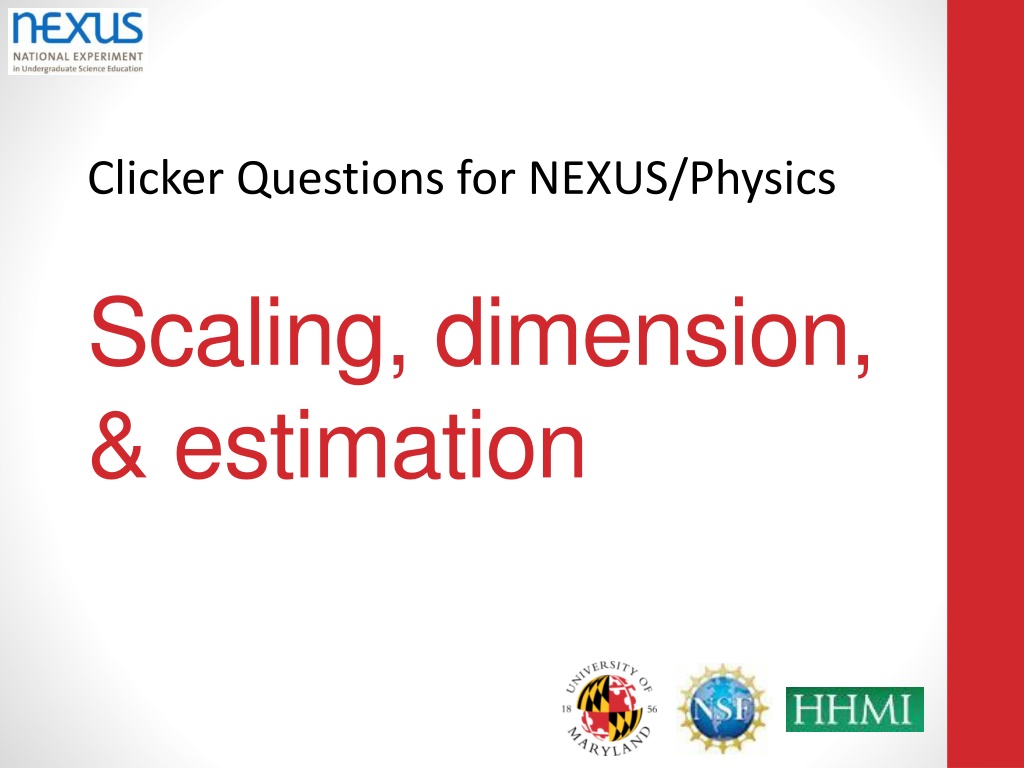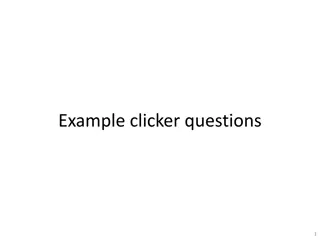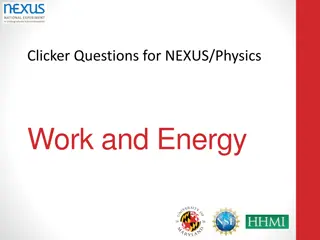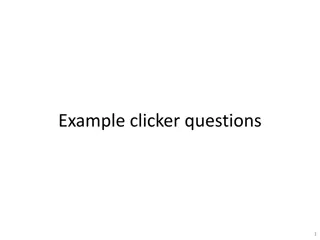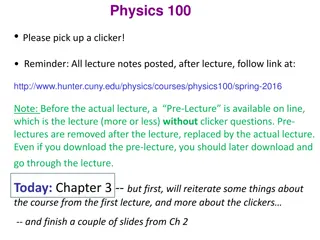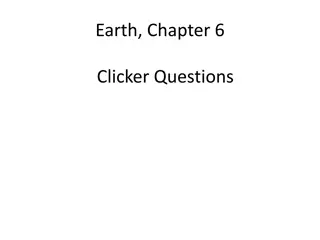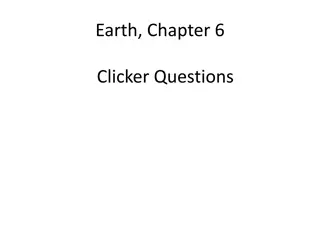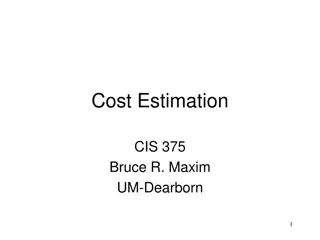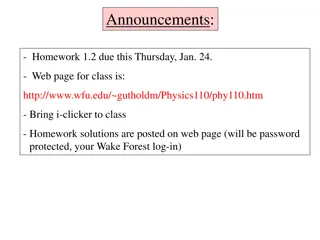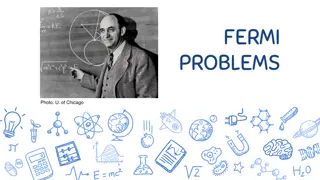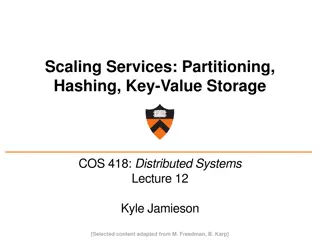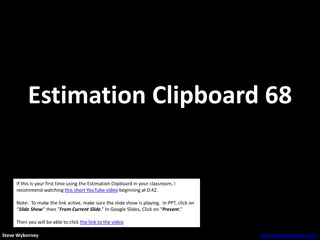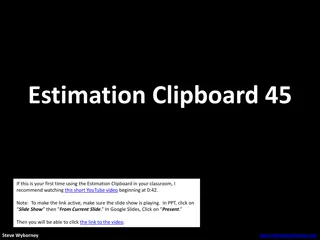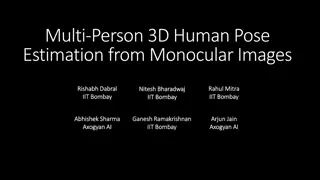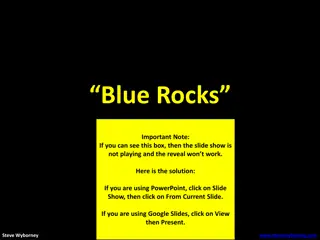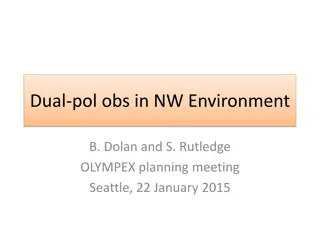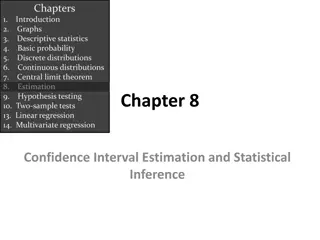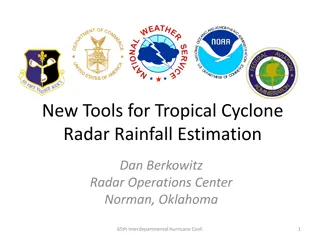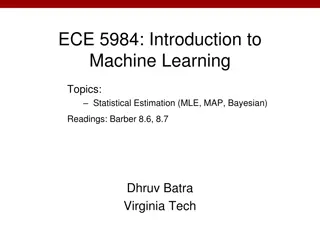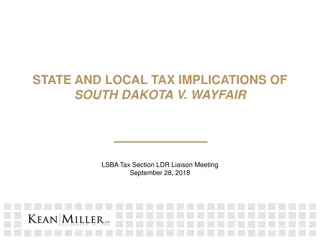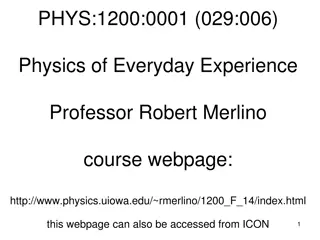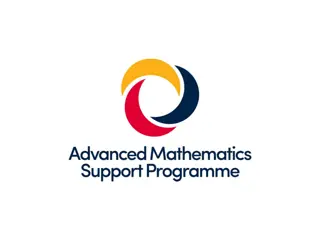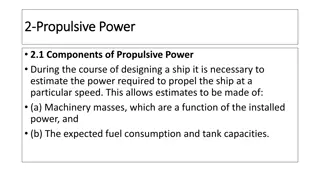Clicker Questions for Nexus Physics: Scaling, Dimension, & Estimation
Purpose of clicker questions in physics instruction is to stimulate class discussion, promote critical thinking, and enhance student understanding. Feedback from students' responses is valuable for probing their thinking, encouraging interaction, and addressing misconceptions. Usage includes encouraging peer discussions, exploring idealizations and hidden assumptions, and fostering problem-solving skills through group activities.
Download Presentation

Please find below an Image/Link to download the presentation.
The content on the website is provided AS IS for your information and personal use only. It may not be sold, licensed, or shared on other websites without obtaining consent from the author. Download presentation by click this link. If you encounter any issues during the download, it is possible that the publisher has removed the file from their server.
E N D
Presentation Transcript
Clicker Questions for NEXUS/Physics Scaling, dimension, & estimation
A note on usage: The clicker slides in this booklet are meant to be used as stimuli to encourage class discussion. They are intended for use in a class that attempts to help students develop a coherent and sophisticated understanding of scientific thinking. They are NOT intended as items to test whether students are right or wrong or know the correct answer by one-step recall if enough cues are given. This has a number of instructional implications that are reviewed in general on the next four slides. The individual slides also contain annotations discussing their intended use.
Usage: 1 Feedback One of the most important values of a clicker- response system is to provide instructors with some understanding of what students are thinking. Good clicker questions can be highly revealing (and surprising). But the critical fact is not that the students make mistakes but to use those mistakes to probe their thinking and find out why. This raises the importance of a rich subsequent discussion well above letting the students know what the right answer is.
Usage 2: Student-student interactions The critical value for student learning occurs in what happens after a clicker question has obtained a mixed response from the students. The standard next cue is, Find someone who disagreed with the answer you chose and see if you can convince them. After a minute or two of discussion, a second click may show students having moved dramatically towards the correct answer. A brief call for who changed their answer and why can lead to a useful exchange. When they have not moved significantly, more discussion is called for.
Usage: 3 Incompletely specified questions Some items have questions that are simple if idealized assumptions are made, subtler if they are not. Part of the discussion of these items are intended to include issues of modeling, idealizations, and hidden assumptions. Questions where answers are not provided. In these items, the intent is to have students come up with potential answers and have the instructor collect them and write them on the board. Occasionally, especially at the beginning of a class, it may take some time before students are willing to contribute answers. It can help if you have some prepared answers ready, walk around the class, and put up the answers as if they came from the students. This can help students get more comfortable with contributing.
Usage: 4 Cluster questions Some questions are meant to be used as part of a group of questions. In this case, resolving the answers to individual questions is better left until the entire group is completed. The value of the questions are often in the comparison of the different items and in having students think about what changes lead to what differences and why. Problem solving items In these items (indicated by a pencil cluster logo), the intent is to have students work together to solve some small problem. After a few minutes, ask the groups to share their answers, vote on the different answers obtained, and have a discussion.
Consider two mathematical models of real world things Distance Time We map positions and times into numbers. What kinds of numbers are we mapping to? 9/5/13 1. Integers 2. Rational numbers 3. Real numbers A. All numbers (+,0,-) B. Non negative only C. Positive only Physics 131 7
Which equation represents the quantity on the left? 2pR 4pR2 4 3pR3 1. A. The area of a circle. B. The volume of a sphere. C. The circumference of a circle. D. The surface area of a sphere. 2. 3. pR2 4.
Which equation could represent the surface area of a cylinder? 2pR+2pRh 2pR2+2pRh 2pR2+2ph 1. 2. 3. 4. pR2h
The diffusion constant D, describes how molecules jiggling around in a fluid drift. It has dimensions [D] = L2/T We have good reason to believe (we ll see it in a reading later) that D depends on the average distance a molecules travels, , and it s average speed v. If [ ] = L and [v] = L/T guess an equation that expresses D in terms of and v. 9/2/16 Physics 131 10
You know that 1 cubic centimeter of water has a mass of 1 gram. What s the mass of one cubic meter of water? A. 10 g B. 102 g C. 104 g D. 106 g E. 1 kg F. 10 kg G. 100 kg H. 1000 kg I. None of these
Measurement is basically about counting but counting what?. N Perim Area Vol 1 2 3
An example from a math exam The population density of trout in a stream is r(x) = 201+ x Writing the equation in this problem on a physics exam would receive 0 credit and the comment: This is a meaningless equation! x2+1 where r is measured in trout per mile and x is measured in miles. x runs from 0 to 10. (a) Write an expression for the total number of trout in the stream. Do not compute it. How would you fix this?
A dollar and a penny A student makes the following argument: "I can prove a dollar equals a penny. Since a dime (10 cents) is one-tenth of a dollar, I can write: 10 = 0.1 $ Square both sides of the equation. Since squares of equals are equal, 100 = 0.01 $. Since 100 = 1 $ and 0.01 $ = 1 it follows that 1$ = 1 ." What's wrong with the argument? Stuck? Try it with 10 cm = 0.1 m
The rate at which an animal in a cold environment loses heat is proportional to its surface area, but its metabolism generates heat in all of its cells, so the rate of heat generation is proportional to its volume. All other factors being equal (which they often are not!), which implications would follow from these facts? 1. Because it is smaller, a baby seal is less at risk for hypothermia (body temperature falling to too low a value) than is an adult when it is in an ocean significantly colder than its body temperature. 2. Because it is smaller, a baby seal is more at risk for hypothermia (body temperature falling to too low a value) than is an adult when it is in an ocean significantly colder than its body temperature.
As part of an exam a few years ago, a student wrote the following derivation of a final result. Without knowing the problem, but knowing the dimensions of each quantity shown along the bottom can you determine: 9/2/15 Is equation D correct? Given that equation D is NOT correct, can you tell which is the first line that has an error? 1. A 2. B 3. C 4. D A. 1. 2. 3. Yes No Can t tell B. C. Physics 131 D. 16 [M]=M [g]=L/T2 [h]=L [ ]=/T [v]=L/T [R]=L [I]=ML2
A student measures distance x to be 5 meters and area A to be 25 ft2. Discuss with neighbors which of the following are true; then vote for all that are true. 9/2/16 1. [x2] = [A] 2. [5x] = A 3. x2 = [A] 4. x2 = A 5. None of the above Physics 131 17
Example x = 5 meters y = 27 inches 18
Is x = y? 1. 2. 3. Yes No Wait, how many meters are in an inch? 19
Is [x] = [y]? 1. 2. Yes No
A student measures distance x to be 5 meters and area A to be 25 ft2. Discuss with neighbors which of the following are true; then vote for all that are true. 1. [x2] = [A] 2. [5x] = A 3. x2 = [A] 4. x2 = A 5. None of the above 21
Your personal scales inches centimeters First digit of thumb Open handspan Forearm (cubit) Full height
Estimate the thickness of a page in a textbook. 1. 100 m 2. 10-1 m 3. 10-2 m 4. 10-3 m 5. 10-4 m 6. 10-5 m 7. 10-6 m 8. 10-7 m 9. 10 8 m
Estimate the number of cells in your body. 1. 100 2. 102 3. 104 4. 105 5. 106 6. 108 7. 1010 8. 1012 9. 1014
Given that the average size of a human cell is about 10 microns across, estimate the number of cells in your hand. 6. 108 7. 1010 8. 1012 9. 1014 1. 100 2. 102 3. 104 4. 105 5. 106
Given that the average size of a human cell is about 10 microns across, estimate the number of skin cells in your hand. 6. 108 7. 1010 8. 1012 9. 1014 1. 100 2. 102 3. 104 4. 105 5. 106
